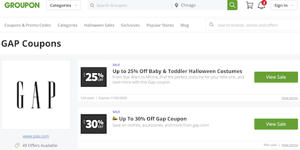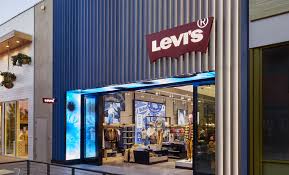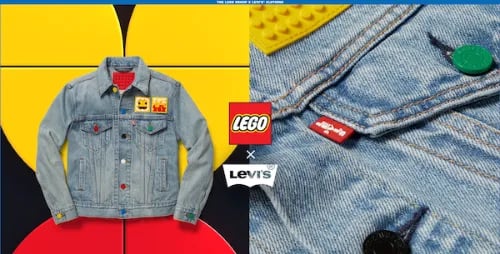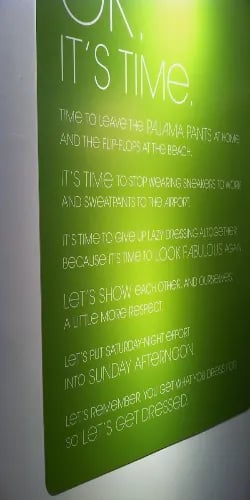Levi’s vs Gap: A Tale of Two Titans and Retail Branding

Subscribe to our newsletter
Branding is so important when it comes to retail. What has changed over the past few years, and what are smart retail brands doing today?
“It was the best of times, it was the worst of times, it was the age of wisdom, it was the age of foolishness…”
While this is the opening to A Tale of Two Cities by Charles Dickens, it’s equally relevant to these crazy times.
Recent news published by the Wall Street Journal reports that the U.S. GDP “grew at a record pace in the third quarter—increasing 7.4% over the prior quarter and at a 33.1% annual rate—recovering about two-thirds of the ground it lost earlier in the coronavirus pandemic.” (The Wall Street Journal, Oct. 29th, 2020)
For the retail industry, the “worst of times” are starting to see more hope, with holiday spending expected to increase as much as 1.5% higher than in 2019, according to Deloitte’s annual holiday retail forecast.
Of course, a quick look around the retail landscape shows us what today’s age of wisdom and foolishness looks like. Every retailer appears to have a different take on social distancing, wearing masks, and other public safety measures.
However, two major brands stand out to me right now: Levi’s and Gap. One is leading the way forward. The other is running away.
A Top Of Mind Brand
Levi’s plans to open approximately 100 new stores over the next several years, and as they announced a few days ago, several of these will be what they're calling Next Gen Prototype stores.
This same week, Gap announced they are exiting malls to shutter about 350 stores by 2024. Gap has been a stalwart in malls all over the world for years now. This is a curious move and Gap CEO Mark Brieitbard even said, "We've been overly reliant on low-productivity, high-rent stores." (The Washington Post, Oct. 22nd, 2020)
On the surface, this may sound like Gap is simply shrinking its footprint because they have too many stores. While that is part of the story, it inaccurately leads readers to focus on Gap’s move signaling the end of malls.
It’s not the fault of the malls that Gap is closing stores.
Gap historically struggles with selling merchandise at full price. It wasn't that many years ago when people touted how smart they were because they had a Groupon that you could buy and stack with some other promotion or discount to get an outrageous sale.
Wait...
GAP is still running Groupons! 
Anyway, I remember walking into one of their stores in Manhattan, and as I walked in, all the salesperson did was hand me a little flier and say, "Here, these items are on sale."
No greeting, no other interaction. Her sole job was only to hand fliers to people.
Frankly, it shows that Gap’s merchandise isn’t that inspiring, a long-time problem that’s now leading to major company-wide disruption.
Pricing issues and consumer awareness are also significant factors contributing to Gap’s current failure.
For example, why would I pay $65 for a pair of full-priced jeans at Gap when I know that Old Navy, which is their sister company, will have them for at least half that price?
Now consider Levi’s approach...
If you’re unaware of the history, Levi's was the main product on which the San Francisco flagship, the Gap, was built because it was a partnership. So many department stores carried Levi’s products, but stores kept running out of stock.
Levi’s created a partnership where Gap would warehouse Levi’s jeans, so their stores had to be big. Then at one point, Gap said, "You know what, we don't need Levi’s. We're going to private label our jeans."
That worked until it didn't work.
And yet, when considering Levi’s state in the retail industry, you can see their pioneering spirit leading the way beyond COVID-19.
A few years ago, I was in the U.K. speaking at an event when I saw the Levi’s store in Milton Keynes.
.webp?width=763&name=IMG_1642%20(1).webp)
Levi’s placed their customization tailor shop at the front of the store, and I immediately thought, “This is smart. This is bound to be where Levi’s is going."
What was refreshingly brilliant about their setup was the lack of promotion signs in the windows or throughout the store. They didn’t want any additional signage to distract from the tailor shop at the forefront of their store.

Levi’s unveiled their Next Gen Prototype store in Palo Alto, California. It features various digital initiatives with plenty of open space for natural traffic flow that can already accommodate social distancing. Having modern and evolving retail footprints increases business value branding.

And those new stores highlight how Levi’s sees a clear path forward, an abundant future, while Gap seems to be shrinking its potential in the same marketplace.
Gap closing their locations and seemingly blaming high rent as the culprit side-steps the actual problem.
Moving locations only kicks the can down the street.
- Why would a shopper spend more to go to a Gap store when they know the same or higher-quality product is available only a short distance away?
- Why should a shopper go out of their way to experience Gap?
- What’s attracting shoppers to step inside a Gap store in the first place?
- What has Gap done to foster brand loyalty?
Your merchandise and branded experience must be compelling if you have any brick-and-mortar presence.
If all you can do is sell at a discount, then your brand isn't going to be a profitable and strong retail brand for long. What's great about Levi's is their out-of-the-box thinking to attract customers.
Levi’s recently announced a new partnership with LEGO. When I heard this news, it piqued my curiosity because what do jeans and building blocks have in common? Not much, if anything, as far as I could see at first glance. A little more digging showed again Levi’s innovative brilliance.
Levi's is creating products with LEGO items embedded in the material that the wearer can decorate with LEGO pieces. A quick review of their LEGO Group x Levi’s sales page shows a mix of iconic LEGO colors with fresh, exciting merchandise made by Levi’s.

This is a great win-win for both brands because it highlights LEGO’s ability to have fun with on-the-go dots, and Levi’s clothing gets a new wave of interest from a younger generation. It’s a partnership of brands that know their customers.
No matter how big of a retailer you are, this can inspire you and your store. How can you collaborate with another brand -- local, regional, whatever scale -- that is a true win-win? This isn’t an email swap or a coupon trade; no, this is a true collaboration. It’s about getting margin, not discounts.
Another area where Levi’s is leading the way is making the world better. The consumer of today isn't comfortable with just giving any retailer money. They want to know how you create a world where we are more alike than different.
We can make the world better, and fixing it is up to us.
Levi’s north star is knowing exactly who they are and who they aren't—Levi’s shares many messages supporting important initiatives tied to hope.
In contrast, it’s much harder to see the same hope-driven intentionality from Gap.
And yet it wasn't always so...

Gap experimented with a new marketing strategy at Piperlime, a retail store they opened in SoHo in 2012. Their assortment, premium brands, and witty signage like this could have gone on to refresh the entire Gap brand. But they closed it down three years later and went all in on discounts.
That wall sign could have been perfect as we moved on from endless Zoom calls.
Until then, if the only thing compelling someone to stand outside on a freezing sidewalk for a shopping experience at Gap is maybe getting a deal, that's not enough.
GAP originally was the cool kids' store that carried every Levi's product in all sizes and was named because of the generation gap between old and young.
Do your employees even know what you care about and what you're doing to make the world a better place?
What is the messaging your shoppers and employees need to hear right now?
That's what will help lower turnover, create more raving fans, and make your employees proud to work for you.
Chip Bergh, the CEO of Levi’s, talked about being accountable to his stakeholders and employees. He was quoted in a recent article by Fortune as saying, "Stakeholder capitalism is a really hot topic now. Number one, I acknowledge that we've not been where we need to be having a diverse, inclusive culture, and I've got a lot of work to do there."
He's taking personal responsibility for moving brand awareness forward. If you are trying to attract Gen Z or millennials, young people to work and shop with you, you better understand that their social convictions determine their wallets.
There are no two ways about it, and one of the things that Bergh has been out in front of recently is ending gun violence. He did a whole op-ed piece. It's not a stretch. The reporter had asked him, "Did you have to pass this by the board first?" He says, "No, we have always been a socially active company." That could become their brand tagline.
Like Dickens’ A Tale of Two Cities, this story highlights two realities, two choices on the road ahead for your retail store.
Will you run away from opportunities and shrink your potential? Or, will you lean into innovation and make the world a better place?
In Sum
Time is short. Let’s make a difference in the world.
Let's use Levi’s as the example that we're putting the stake in the ground and saying, "We are going to innovate, we are going to find new ways, and we're going to be full of hope."
We can’t afford to close up and kick the can down the road.
We need to find a way forward because the future is bright for those willing to do what’s right for our world.
One of the key topics I cover in my SalesRX retail sales training program is about creating an exceptional experience for your customers. Training your employees is about knowing how you want to show up in every customer conversation and interaction on social media, online, and in person.



